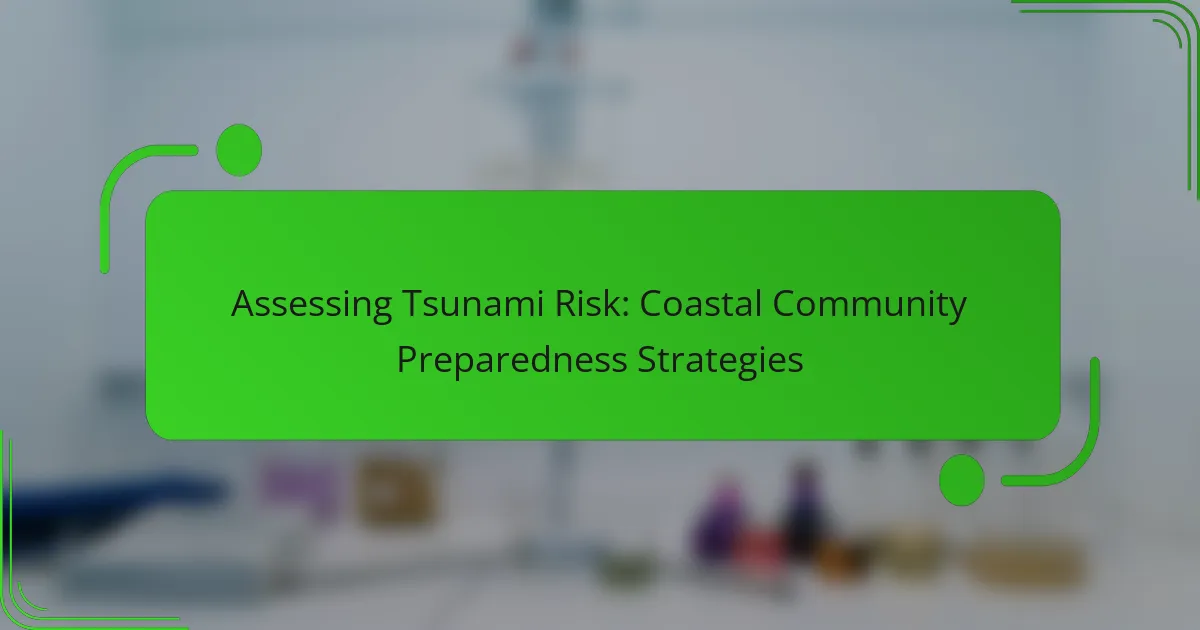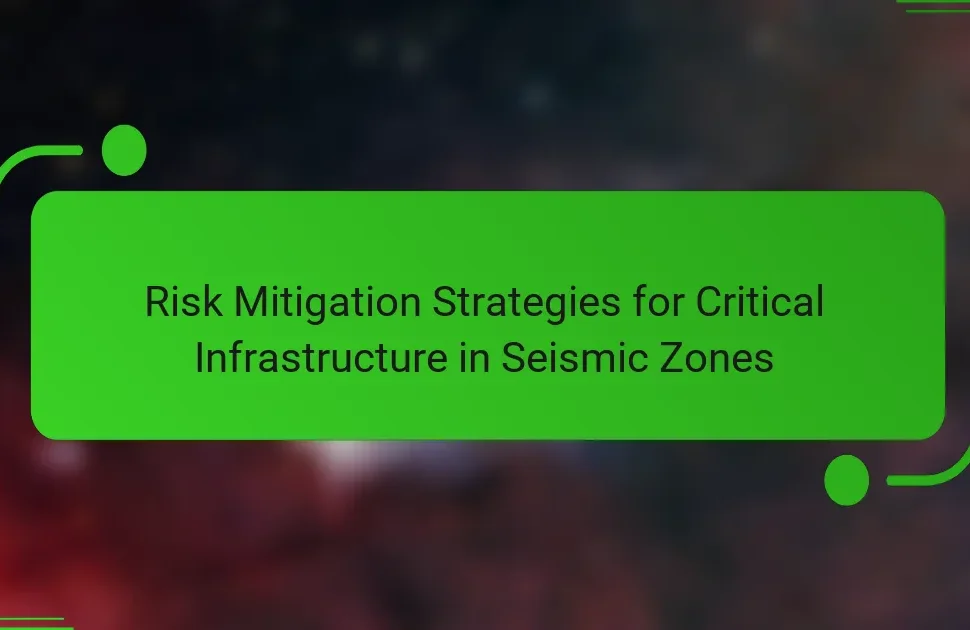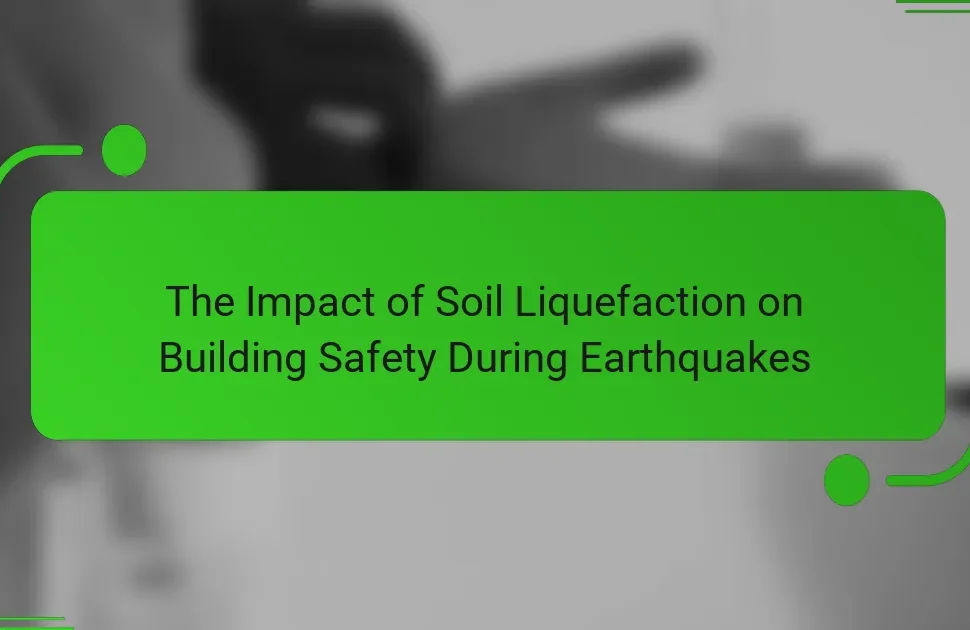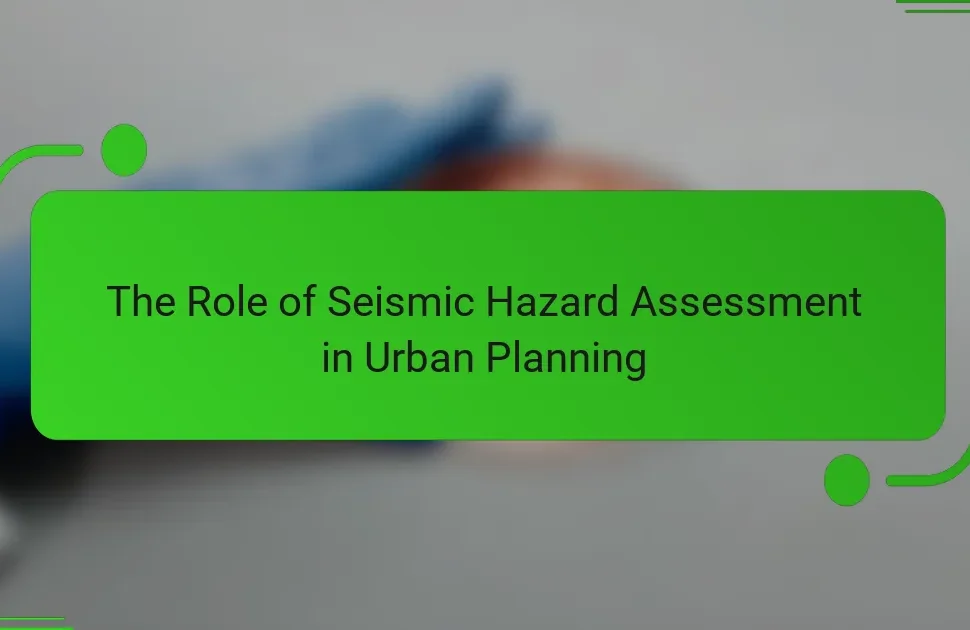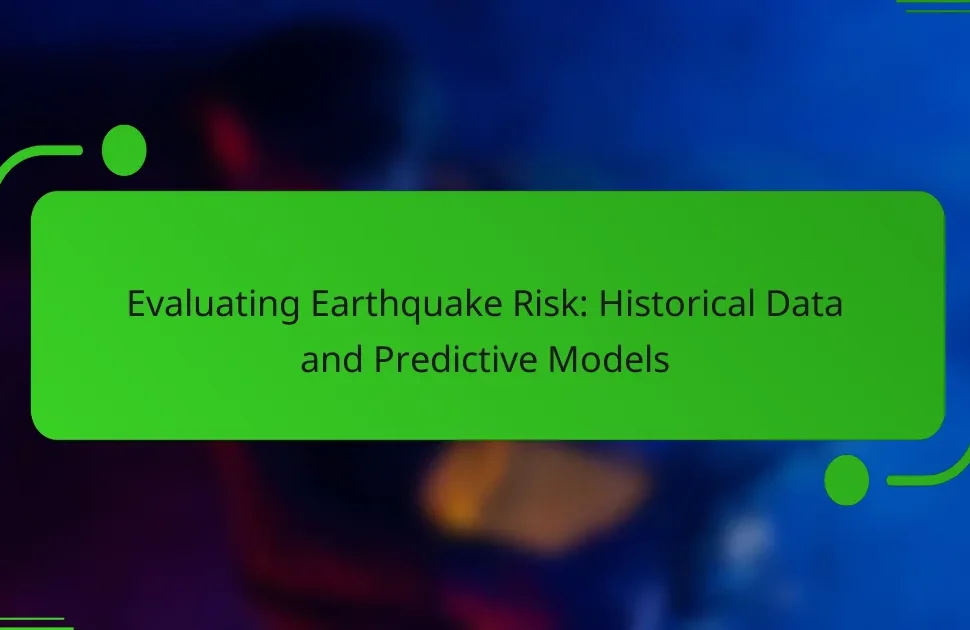Tsunami risk assessment evaluates the potential impact of tsunamis on specific coastal areas by analyzing historical data, geological features, and population density. This process identifies vulnerable locations and populations, informing emergency preparedness and response strategies to minimize casualties and property damage. Key strategies for tsunami preparedness include developing and updating evacuation plans, establishing early warning systems, engaging in coastal land-use planning, and fostering partnerships among various agencies. Best practices involve conducting regular risk assessments, educating the public on tsunami risks, and ensuring community readiness through drills and collaboration. These comprehensive efforts enhance the resilience of coastal communities against tsunami threats.

What is Tsunami Risk Assessment?
Tsunami risk assessment is the process of evaluating the potential impact of tsunamis on a specific area. It involves analyzing historical tsunami data, geological features, and population density. This assessment helps identify vulnerable locations and populations at risk. It also examines the likelihood of tsunami occurrences based on seismic activity. Effective tsunami risk assessments inform emergency preparedness and response strategies. According to the National Oceanic and Atmospheric Administration (NOAA), such assessments are crucial for minimizing casualties and property damage. They enable communities to develop effective evacuation plans and public awareness campaigns.
How is tsunami risk assessed in coastal communities?
Tsunami risk in coastal communities is assessed through a combination of geological studies, historical data analysis, and modeling techniques. Geological studies identify fault lines and potential tsunami sources. Historical data provides insight into past tsunami events and their impacts. Modeling techniques simulate tsunami wave behavior and inundation patterns. These assessments help determine vulnerable areas and potential evacuation routes. The National Oceanic and Atmospheric Administration (NOAA) provides guidelines and tools for effective risk assessment. Communities use this information to develop preparedness plans and response strategies. Regular drills and education programs enhance community resilience against tsunamis.
What factors contribute to tsunami risk in coastal areas?
Tsunami risk in coastal areas is influenced by several factors. These include geological features, seismic activity, and oceanic conditions. Coastal regions near tectonic plate boundaries are at higher risk. Subduction zones often generate powerful earthquakes. These earthquakes can displace large volumes of water, leading to tsunamis. Additionally, coastal topography affects wave height and inundation. Low-lying areas are particularly vulnerable to flooding. Historical data shows that regions with past tsunami events face heightened risk. For example, the 2004 Indian Ocean tsunami resulted from an undersea earthquake. This highlights the importance of monitoring seismic activity in risk assessment.
How do historical data and modeling influence risk assessment?
Historical data and modeling are crucial for effective risk assessment in tsunami preparedness. Historical data provides insights into past tsunami events, including their frequency, magnitude, and impacts on coastal communities. This information helps identify vulnerable areas and populations that are at higher risk.
Modeling complements historical data by simulating potential tsunami scenarios. Advanced models can predict wave heights, inundation zones, and the time it takes for a tsunami to reach the shore. These simulations allow communities to visualize possible outcomes and plan accordingly.
Research shows that integrating historical data with modeling improves the accuracy of risk assessments. For example, a study by the National Oceanic and Atmospheric Administration (NOAA) found that areas using both data sources had more effective evacuation plans and response strategies. By combining these elements, coastal communities can enhance their preparedness and resilience against future tsunami threats.
Why is preparedness important for coastal communities?
Preparedness is crucial for coastal communities to mitigate the impacts of natural disasters. Coastal areas are often at risk from tsunamis, hurricanes, and flooding. Effective preparedness can save lives and reduce property damage. Studies show that communities with preparedness plans recover more quickly. For example, the National Oceanic and Atmospheric Administration (NOAA) states that early warning systems can reduce fatalities by 80%. Preparedness includes education, evacuation plans, and resource allocation. These strategies help ensure community resilience during emergencies. Overall, preparedness enhances safety and stability for coastal residents.
What are the potential impacts of a tsunami on coastal communities?
Tsunamis can cause significant destruction to coastal communities. They lead to loss of life, with historical events showing thousands of fatalities. Infrastructure damage is extensive, including homes, roads, and bridges. The economic impact can reach billions in recovery costs. Tsunamis also result in environmental degradation, affecting ecosystems and water quality. Displacement of populations occurs, requiring emergency shelters and long-term relocation plans. Public health risks increase due to contaminated water and lack of medical services. Recovery can take years, impacting community resilience and sustainability.
How does preparedness mitigate the effects of a tsunami?
Preparedness mitigates the effects of a tsunami by enabling communities to respond effectively and reduce damage. Preparedness includes creating evacuation plans and conducting drills. These actions ensure that residents know safe routes and procedures during an emergency. Early warning systems are also a critical component of preparedness. They provide timely alerts, allowing people to evacuate before the tsunami strikes. Research shows that communities with established preparedness plans experience lower casualties and property damage. For example, after the 2004 Indian Ocean tsunami, areas with effective preparedness strategies had significantly better outcomes. Thus, preparedness directly influences the resilience of coastal communities against tsunamis.
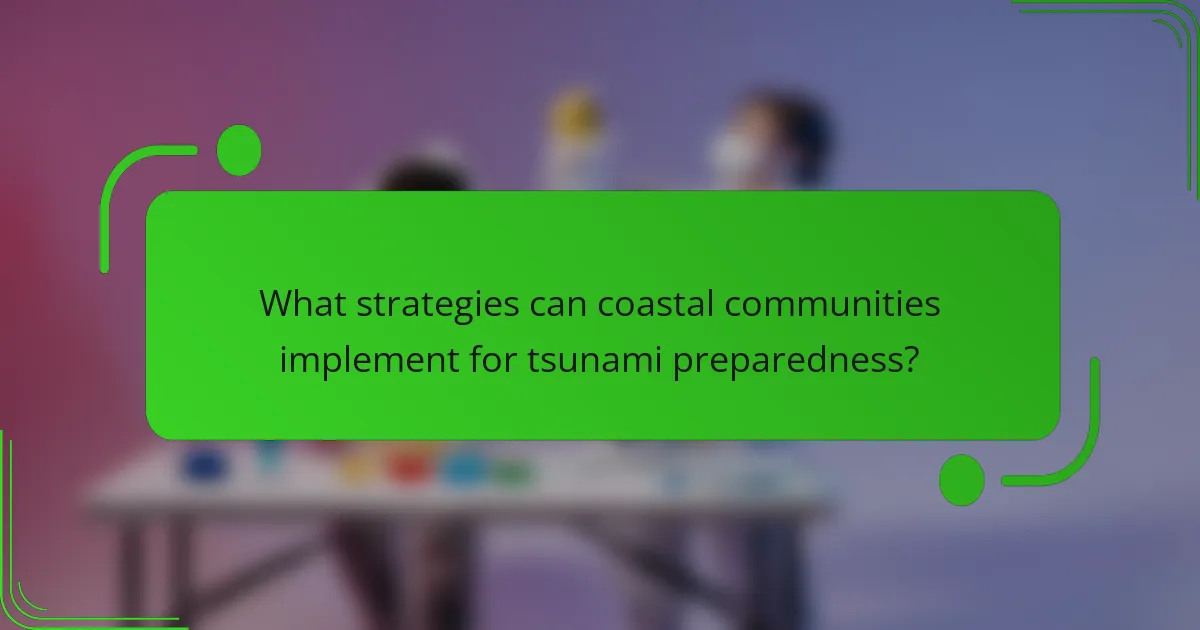
What strategies can coastal communities implement for tsunami preparedness?
Coastal communities can implement several strategies for tsunami preparedness. First, they should develop and regularly update tsunami evacuation plans. These plans must identify safe routes and designated evacuation zones. Community drills should be conducted to ensure residents are familiar with these plans.
Second, establishing early warning systems is crucial. These systems can provide timely alerts to residents about impending tsunamis. Investing in public education campaigns helps raise awareness about tsunami risks and safety measures.
Third, communities should engage in coastal land-use planning. This includes restricting development in high-risk areas. Additionally, constructing tsunami-resistant infrastructure can minimize damage during an event.
Lastly, fostering partnerships with local, state, and federal agencies enhances preparedness efforts. Collaboration can improve resource allocation and response coordination. These strategies collectively strengthen coastal communities’ resilience to tsunamis.
How can early warning systems enhance community readiness?
Early warning systems enhance community readiness by providing timely alerts about impending threats. These systems monitor environmental changes, such as seismic activity, to predict tsunamis. When a tsunami is detected, alerts are sent to communities at risk. This allows residents to evacuate to safer areas before the tsunami strikes. Research indicates that timely warnings can significantly reduce casualties. For example, the 2004 Indian Ocean tsunami highlighted the need for effective early warning systems. Implementing such systems has been shown to improve response times and preparedness in coastal areas. Overall, early warning systems are crucial for enhancing community resilience against tsunami threats.
What technologies are used for tsunami early warning?
Tsunami early warning technologies include seismic sensors, deep-ocean buoys, and satellite systems. Seismic sensors detect earthquakes that may trigger tsunamis. They provide real-time data on ground movement. Deep-ocean buoys measure changes in sea level. These buoys transmit information about wave height and tsunami formation. Satellite systems monitor ocean surface conditions from space. They help track tsunami waves over large distances. Together, these technologies enhance the accuracy and speed of tsunami warnings. The integration of these systems is crucial for effective disaster response.
How do communities effectively communicate warnings to residents?
Communities effectively communicate warnings to residents through multiple channels. These include sirens, text alerts, social media, and community meetings. Sirens provide immediate auditory alerts for emergencies. Text alerts reach residents quickly on their mobile devices. Social media platforms disseminate information widely in real-time. Community meetings educate residents about risks and preparedness strategies. Research shows that multi-channel communication increases the likelihood of residents receiving warnings. The National Oceanic and Atmospheric Administration (NOAA) emphasizes the importance of redundancy in communication methods for effective warning dissemination.
What role does education and training play in tsunami preparedness?
Education and training are crucial for effective tsunami preparedness. They equip communities with knowledge about tsunami risks and response strategies. Training programs often include evacuation drills and emergency response protocols. These initiatives enhance public awareness and preparedness levels. Research indicates that communities with regular training experience lower casualty rates during tsunamis. For instance, a study by the United Nations Office for Disaster Risk Reduction found that education significantly improves community resilience. Therefore, education and training play a vital role in minimizing the impact of tsunamis.
How can community drills improve response times?
Community drills can significantly improve response times during emergencies. They provide hands-on experience for participants, enabling them to practice and refine their skills. Regular drills enhance coordination among community members and emergency responders. This practice leads to quicker decision-making in real situations. Studies show that communities with regular drills can reduce response times by up to 30%. Familiarity with evacuation routes and procedures is established through repeated drills. This preparation helps alleviate panic and confusion during actual emergencies. Overall, community drills are essential for effective emergency preparedness and response.
What resources are available for educating residents about tsunamis?
Educational resources for residents about tsunamis include government websites, community workshops, and informational brochures. The National Oceanic and Atmospheric Administration (NOAA) provides extensive online resources. These resources cover tsunami safety, preparedness, and evacuation routes. Local emergency management agencies often conduct workshops to educate residents. Schools may also incorporate tsunami education into their curricula. The Pacific Tsunami Warning Center offers alerts and educational materials. Community organizations sometimes host events to raise awareness. These resources aim to enhance community preparedness and safety.

What are some best practices for assessing and improving tsunami preparedness?
Best practices for assessing and improving tsunami preparedness include conducting regular risk assessments. Communities should identify vulnerable areas and populations. Developing evacuation plans is crucial for effective response. Regular drills enhance community readiness and awareness. Establishing early warning systems ensures timely alerts. Engaging local stakeholders fosters collaboration and resource sharing. Educating the public on tsunami risks and safety measures increases resilience. Reviewing and updating preparedness plans regularly is essential to adapt to changing conditions.
How can communities evaluate their current preparedness levels?
Communities can evaluate their current preparedness levels through comprehensive assessments. They should conduct surveys to gather data on emergency plans and resources. Engaging with local emergency management agencies is crucial for accurate evaluations. Communities can also organize drills to test response capabilities and identify gaps. Analyzing historical data on past tsunami events provides context for preparedness levels. Additionally, community workshops can facilitate discussions on preparedness and gather feedback. Regularly reviewing and updating preparedness plans is essential for ongoing evaluation. This systematic approach ensures communities remain ready for potential tsunami threats.
What metrics should be used to assess tsunami preparedness?
Key metrics to assess tsunami preparedness include early warning systems, community education levels, evacuation plans, and infrastructure resilience. Early warning systems should provide timely alerts to populations at risk. Community education levels can be measured by the percentage of residents who understand tsunami risks and response protocols. Evacuation plans must be evaluated for accessibility and effectiveness, ensuring that routes are clear and well-marked. Infrastructure resilience can be assessed by analyzing the ability of buildings and critical facilities to withstand tsunami impacts. Regular drills and community engagement in preparedness activities further indicate readiness. These metrics are vital for improving community response and reducing potential casualties during a tsunami event.
How can communities identify gaps in their preparedness plans?
Communities can identify gaps in their preparedness plans by conducting comprehensive assessments. These assessments should involve reviewing existing plans against current best practices. Engaging local stakeholders is crucial for gathering diverse perspectives. Communities can also utilize drills and simulations to test their plans in real-time scenarios. Analyzing the outcomes of these exercises will highlight weaknesses. Additionally, communities should seek feedback from emergency responders and residents after drills. Regularly updating plans based on new information and technologies is essential. Research indicates that continuous evaluation improves preparedness effectiveness, as shown in the Federal Emergency Management Agency’s guidelines.
What are some common challenges in tsunami preparedness?
Common challenges in tsunami preparedness include inadequate early warning systems and insufficient public awareness. Many coastal communities lack effective communication channels for alerting residents. This can lead to delayed evacuations during a tsunami event. Limited funding for preparedness programs also hampers effective planning and training. Some areas may not have access to the necessary resources for infrastructure improvements. Additionally, varying levels of risk perception can affect community response. People may underestimate the threat due to past experiences or misinformation. Lastly, geographic limitations can hinder evacuation routes and safe zones. These challenges complicate efforts to enhance tsunami preparedness in vulnerable regions.
How can communities overcome barriers to effective preparedness?
Communities can overcome barriers to effective preparedness by enhancing communication and collaboration. Establishing clear channels for information sharing is crucial. Regular training and drills can improve community readiness. Engaging local leaders fosters trust and encourages participation. Utilizing technology can streamline preparedness efforts. Access to resources and funding supports program development. Building partnerships with organizations strengthens community resilience. Research shows that communities with strong networks respond more effectively to disasters.
What lessons have been learned from past tsunami events?
Past tsunami events have taught critical lessons about preparedness and response. Effective early warning systems are essential for saving lives. The 2004 Indian Ocean tsunami highlighted the need for global communication networks. Communities must conduct regular drills to ensure readiness. Public education on tsunami risks is crucial for community resilience. Infrastructure should be designed to withstand tsunami impacts. Coastal zones require strict land-use planning to minimize risk. Finally, collaboration among local, national, and international agencies enhances response effectiveness.
What practical steps can coastal communities take to enhance their tsunami preparedness?
Coastal communities can enhance their tsunami preparedness by developing and implementing comprehensive evacuation plans. These plans should include clearly marked evacuation routes and designated safe zones. Regular tsunami drills should be conducted to familiarize residents with evacuation procedures. Communities should invest in early warning systems to alert residents of impending tsunamis. Public education campaigns can raise awareness about tsunami risks and preparedness measures. Infrastructure improvements, such as building tsunami-resistant structures, are also crucial. Collaborating with local government and emergency services can ensure a coordinated response during a tsunami event. Studies show that communities with robust preparedness measures can significantly reduce casualties and property damage during tsunamis.
How can collaboration with local organizations improve preparedness efforts?
Collaboration with local organizations can significantly enhance preparedness efforts. Local organizations possess unique insights into community needs and resources. They can facilitate training programs tailored to specific risks, such as tsunamis. This localized knowledge allows for more effective communication strategies during emergencies. Involving local entities fosters trust and encourages community engagement. Studies show that communities with strong local partnerships are better prepared for disasters. For instance, the National Preparedness Report 2020 highlights that collaborative networks improve response times and resource allocation. Engaging local organizations ensures that preparedness plans are culturally relevant and widely supported.
What resources are available to support community preparedness initiatives?
Resources available to support community preparedness initiatives include federal grants, training programs, and local partnerships. Federal grants, such as those from FEMA, provide funding for disaster preparedness projects. Training programs, like Community Emergency Response Teams (CERT), educate citizens on emergency response. Local partnerships with organizations like the Red Cross enhance resource sharing and community engagement. Additionally, online tools and resources from the National Oceanic and Atmospheric Administration (NOAA) offer valuable information on tsunami preparedness. Studies show that communities with these resources are better equipped to respond to disasters effectively.
The main entity of the article is tsunami risk assessment, focusing on coastal community preparedness strategies. The article outlines the process of evaluating tsunami risks, including historical data analysis, geological studies, and modeling techniques that inform emergency response and evacuation plans. It emphasizes the importance of preparedness in mitigating the impacts of tsunamis, detailing best practices such as developing evacuation routes, establishing early warning systems, and conducting community drills. Additionally, the article discusses the role of education, collaboration with local organizations, and the use of technology in enhancing community resilience against tsunami threats.
